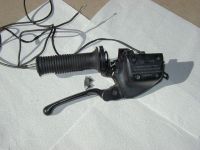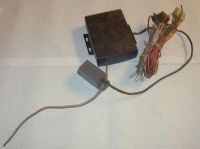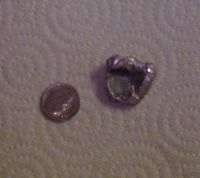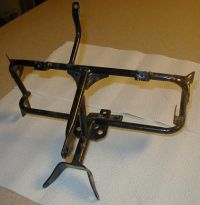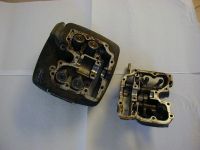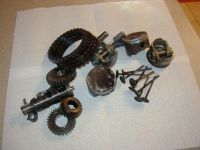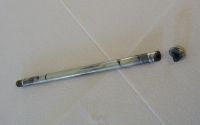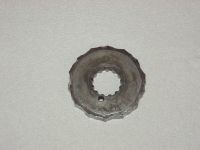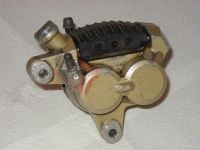Box of Shame #9: When brakes break…
Author: site admin
Category: The Box Of Shame
It has been awhile since I posted a Box of Shame posting mainly because I have been running out of interesting parts to talk about. Well, I’m man of action. As someone who is always willing to do whatever is necessary to improve the blog, I decided to create a new item last week which I can add to the Box of Shame.
First, the background: Thursday night, a little over a week ago, I ended up being at work until late. I then got home late and was then up even later trying to get caught up on my back log of computer and blog duties. The bedside clock showed 2am when I finally staggered off to bed and that same clock wasn’t looked upon too warmly when it started blaring at me to get up at 7:30 the next morning. Even as I struggled out of bed on Friday, I told my wife that I was probably too tired to ride but since I needed to go into Denver that afternoon to watch the Iron Butt Rally checkpoint I decided to ride anyway. That faint sound you hear in the background is the ominous music portion of my life’s soundtrack starting to play.
Now I have a *great* commute into work each day. The first 17 miles are prime paved twisties which drop 3,000 ft of elevation from the town of Nederland to the town of Boulder. In addition to this route which I take nearly every day, there is an entire network of old dirt mining roads that criss-cross the area and offer alternative routes. This morning, despite feeling like I had a bag of cotton balls crammed between my ears, I decided to take an alternate route down one of these mining roads rather than the paved road that I know like the back of my hand. By the way, feel free to put in ear plugs right now if the ominous music is getting too loud.
Finally, I let the fresh morning air and the excitement of checking out the Iron Butt stuff get to me and I actually started having fun with the ride. Now don’t get me wrong I’m all for fun, especially on motorcycles, its just that there is fun and there is FUN. FUN often involves doing stupid things like riding too fast or taking unnecessary risks. Things that initially seem FUN might start with the famous “Hey Bubba, watch this…” intro. In a relatively short amount of time I went from having fun to having FUN on the big Beemer…on deserted dirt roads…while sleepy. Uh-oh. The end result is that after sliding the bike around a few turns, the FUN knob got turned up to eleven which resulted in the bike getting way out of shape around a gravel coated left hander. Despite doing everything wrong (panic, cuss loudly in helmet and chop throttle) I managed not to get high-sided off the mountainside but did get enough off course that I couldn’t gather things back up. I ended up bouncing along right at the edge of the road where the big rocks and gnarly ruts are located.
It was then that a very inconveniently placed 5 ft deep nettle-filled ditch called a halt to the proceedings. Dumping a 700 lb bike into a yawning abyss is not a good idea at the best of times. It is certainly not a good idea at 8am during a work week on an empty road in the middle of nowhere. The good news is that the mix of nettles, wild raspberry bushes and assorted other weeds which filled this drainage area where so thick they acted as a sort of spring mattress for the bike. The really good news is that an Aerostich riding suit offers equally good protection against thorn bushes as it offers against pavement rash. I would probably still be pulling stickers out of my butt if I’d been wearing jeans.
It took me nearly 45 minutes to disassemble the bike (remove the tank bag, remove the saddle bags, remove the tank) and drag it up the incline to road level. Since the bike landed upside down in the ditch I wasn’t sure I could muscle the thing back upright, even with the gas tank removed, when a somewhat baffled truck happened to drive along. The owner thankfully helped me make the “flip” and then I spent another 10 minutes reassembling the bike. I then had to tear into the right hand instrument pod since the throttle was sticking. What I found when I took the various covers off was that the mirror mounts to brackets built into the front brake master cylinder. When the bike landed on the right side mirror, it broke that bracket which jammed metal into the throttle housing. I pried the chunks of metal out and put it all back together. The only other noticeable issue was the ABS computer was reporting a fault. I had no fun (and certainly no FUN) continuing on into work but at least the bike was rideable…its the old “any landing you can walk away from is a good landing” theory.
Once I got to work I called the local BMW shop and ordered a new master cylinder. Its a little known fact but apparently the Germans have found that solid gold makes a better material for building bike parts than the traditional materials. I don’t know how they manage to make a precious metal look like common aluminum but based on the price of a BMW master cylinder it would certainly seem to be gold. I also downloaded the necessary instructions from the Internet BMW Riders web site on how to reset the ABS computer. This past weekend I replaced the broken master cylinder, reset the computer and tried to buff out the various scratches. Other than a few new beauty marks, the bike is remarkably unscathed.
No matter how much I complain about the cost of the GS, it is definitely a rugged bike. To get flipped upside down into a 5 ft deep ditch and come back out so lightly damaged is really amazing. The moral of this Box of Shame entry? Don’t have too much FUN, especially if your brain isn’t working at 100%. The second moral? No matter how clear your mental faculties, a 700 lb adventure touring bike is *not* a 200 lb dirt bike. I need to save the dirt track antics for the the DRZ.
[image from my photo collection.]
